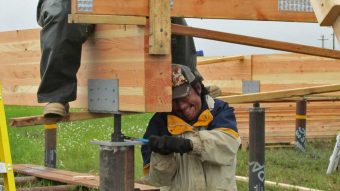Ground Source Heat Pumps
Ground Source Heat Pump Demonstration at CCHRC
CCHRC installed a ground source heat pump (GSHP) system at its Fairbanks facility in 2012 to see how it handles extremely cold soils. The GSHP displaced an oil-fired boiler to provide heat to a 5,000 square foot space. A previous study with the Alaska Center for Energy and Power determined that GSHPs have the potential to save money for Alaskans, depending on the site conditions and energy costs (see the Ground Source Heat Pumps in Cold Climates study below). In parts of the state that rely on expensive diesel, such as Juneau, Fairbanks and Seward,.we found that GSHPs could provide significant cost savings. Yet there are still unanswered questions about GSHPs in cold climates, including their long-term efficiency and their effect on ground temperatures.
Because GSHPs extract geothermal energy from the earth instead of burning fuel to generate heat, site-specific considerations are critical. The land around CCHRC formerly contained permafrost up to the surface, but in the past decade has thawed down to approximately 25 feet. This provides a narrow layer for extracting heat between the area of seasonal frost and the underlying permafrost. These are challenging conditions for the operation of a heat pump system and provide a rigorous testing environment for GSHPs in Alaska.
This project also looks at potential changes in the thermal regime of the soil. For example, does harvesting geothermal heat lower the temperature of the ground and thereby lower the efficiency of the heat pump? In addition, how do different surface treatments, like grass or rocks, affect the ability of the ground to be recharged by the sun?
Lessons learned during the design, installation, and maintenance of the GSHP provide valuable insight into the potential of GSHPs in Alaska and the optimal design for cold climates.
Ground Source Heat Pump with Solar Thermal Recharge
To address the issue of cold ground in Alaska, CCHRC designed a system that combined a ground source heat pump with solar thermal collectors that would recharge the ground in the summer. The system was installed at Weller Elementary School in the Fairbanks North Star Borough. The experimental project tested how the technology works in a large building with a high heating demand. It is a hybrid, or combined, system because it integrates a heat pump with solar thermal panels. Because the heat pump extracts warmth from the ground during the year, it poses the risk of creating more permafrost and depleting the heat source.
To compensate, CCHRC added solar panels to the school’s roof to restore heat to the ground. The panels contain tubes filled with a fluid that absorbs heat from the sun. The tubes deposit the heat back to the ground area where we are taking it.










